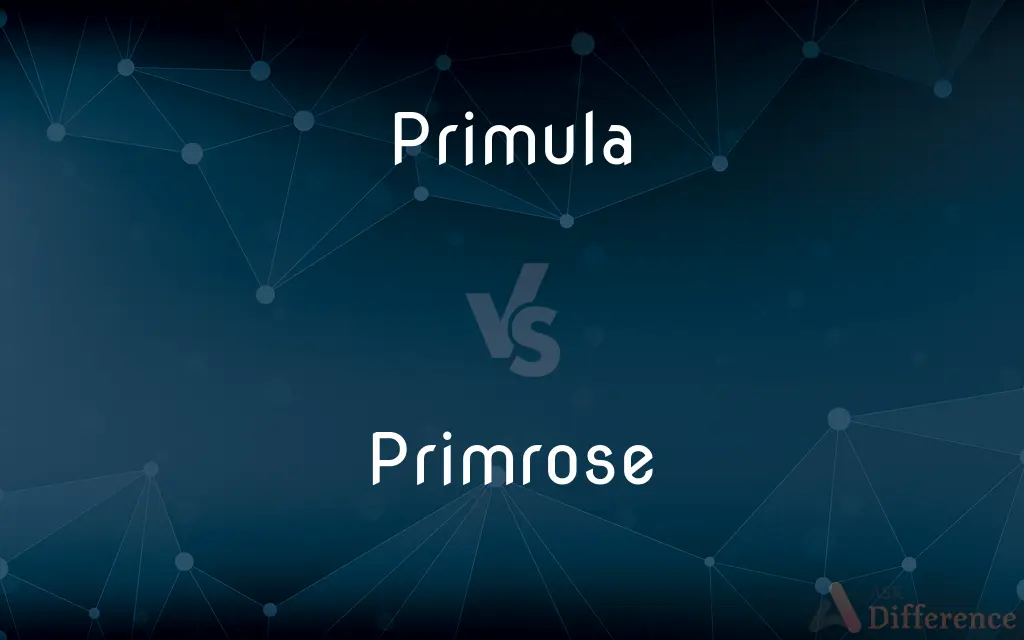Primula vs. Primrose — What's the Difference?
By Tayyaba Rehman & Maham Liaqat — Updated on March 27, 2024
Primula is a genus of flowering plants in the family Primulaceae, known for diverse species and colors, while primrose specifically refers to early-blooming species within this genus, often in yellow.

Difference Between Primula and Primrose
Table of Contents
ADVERTISEMENT
Key Differences
Primula encompasses a wide genus of plants with varied species, exhibiting a broad range of colors, growth habits, and flowering times. Whereas primrose typically denotes the Primula vulgaris, a species well-known for its early spring bloom and distinct yellow flowers.
Primula species can be found in a variety of habitats, including woodlands, marshes, and alpine regions, showcasing the genus's adaptability. On the other hand, primroses are commonly associated with woodlands and meadows in temperate regions, thriving in partially shaded areas.
The care requirements for Primula plants vary widely across the genus, with some species preferring moist, well-drained soil and others thriving in drier, more rocky soils. Primroses, however, generally prefer moist, rich soil and can often be found naturalizing under deciduous trees.
Primula offers gardeners a wide selection of plants, including perennial, biennial, and annual varieties, suitable for a range of garden designs and purposes. Conversely, primroses are perennial in nature, offering consistency and reliability for spring color in garden settings.
The flowering time for Primula plants can range from early spring to late summer, depending on the species. Primroses, however, are among the first to bloom in spring, signaling the end of winter with their vibrant colors.
ADVERTISEMENT
Comparison Chart
Definition
A genus of flowering plants with diverse species.
A species within the Primula genus, often symbolizing early spring.
Habitat
Varied, including woodlands, marshes, and alpine regions.
Primarily woodlands and meadows in temperate regions.
Soil Preference
Ranges widely from moist, well-drained to dry, rocky soils.
Prefers moist, rich soil.
Plant Type
Includes perennials, biennials, and annuals.
Mostly perennials.
Flowering Time
Ranges from early spring to late summer.
Early spring.
Compare with Definitions
Primula
Primula is a diverse genus of flowering plants in the Primulaceae family.
The gardener added several Primula species to the shade garden for variety.
Primrose
Primrose refers to several species in the Primula genus, notable for their early bloom.
The yellow primrose is a sign that spring has arrived.
Primula
Some Primula species are known for their rosette of leaves and umbrella-like flowers.
The Primula denticulata, with its spherical flower clusters, is a spring favorite.
Primrose
The common primrose (Primula vulgaris) is a perennial herb with pale yellow flowers.
Wild primroses dotted the woodland floor, brightening the scene.
Primula
Primulas can vary in height, color, and blooming time.
Primula japonica brings a splash of color to the garden in late spring.
Primrose
This plant prefers partially shaded spots and rich, well-drained soil.
The primroses thrived under the oak tree, where it's cool and shaded.
Primula
Many Primulas prefer moist conditions and partial shade.
She planted Primulas by the pond where it's moist and shady.
Primrose
Primroses are often used in gardens for early spring color.
Planting primroses along the walkway welcomes visitors with cheerful blooms.
Primula
The genus includes both annual and perennial plants.
Annual Primulas add quick color, whereas perennials return each year.
Primrose
Primroses symbolize youth and renewal in many cultures.
She gave a bouquet of primroses to symbolize a fresh start.
Primula
Primula () is a genus of herbaceous flowering plants in the family Primulaceae. They include the primrose (P. vulgaris), a familiar wildflower of banks and verges.
Primrose
Any of numerous plants of the genus Primula, having large basal leaves and clusters of variously colored flowers with a five-lobed bell-shaped or salverform corolla. Also called primula.
Primula
See primrose.
Primrose
A flowering plant of the genus Primula.
Primula
(botany) Any plant of the genus Primula; the primroses.
Primrose
Specifically, the species Primula acaulis (syn. Primula vulgaris), also called common primrose.
Primula
The genus of plants including the primrose (Primula vera).
Primrose
A plant of the family Primulaceae.
Primula
Any of numerous short-stemmed plants of the genus Primula having tufted basal leaves and showy flowers clustered in umbels or heads
Primrose
A plant of the genus Oenothera, better known as an evening primrose.
Primrose
A flower of a primrose plant.
Primrose
A light yellow colour.
Primrose
Of a light yellow colour.
Primrose
(intransitive) To pick primroses.
We went primrosing on Sunday and returned with a full basket.
Primrose
An early flowering plant of the genus Primula (Primula vulgaris) closely allied to the cowslip. There are several varieties, as the white-, the red-, the yellow-flowered, etc. Formerly called also primerole, primerolles.
Primrose
Of or pertaining to the primrose; of the color of a primrose; - hence, flowery; gay.
Primrose
Any of numerous short-stemmed plants of the genus Primula having tufted basal leaves and showy flowers clustered in umbels or heads
Common Curiosities
How do you care for primroses?
Keep the soil moist but well-drained, provide partial shade, and remove spent flowers to encourage more blooms.
What is the main difference between Primula and primrose?
Primula refers to the entire genus of flowering plants, while primrose specifically denotes species within this genus that bloom early in spring.
When do Primulas bloom?
Primulas bloom from early spring to late summer, depending on the species.
Can primroses grow in full sun?
Primroses prefer partial shade but can tolerate morning sun with adequate moisture.
Do Primulas need to be deadheaded?
Yes, deadheading Primulas can encourage more blooms and extend the flowering period.
Do primroses attract wildlife?
Yes, primroses can attract bees, butterflies, and other pollinators to the garden.
Can Primula plants be grown indoors?
Yes, some Primula species can be grown indoors, provided they receive sufficient light and humidity.
Are primroses edible?
Yes, the flowers of some primrose species are edible and can be used in salads or as garnishes.
Are all Primulas perennials?
No, the Primula genus includes perennials, biennials, and annuals.
What colors do primroses come in?
Primroses can be found in a range of colors including yellow, pink, red, purple, and white.
What soil pH is ideal for Primulas?
Primulas generally prefer slightly acidic to neutral soil pH.
How long do primrose plants live?
Primroses are perennials and can live for several years with proper care.
What is the best way to propagate primroses?
Primroses can be propagated by division after flowering or by seed.
Are primroses toxic to pets?
Primroses are generally considered non-toxic to pets, but it's always best to check specific species for safety.
Can primroses survive frost?
Primroses are quite hardy and can survive light frosts, especially if they're well-established.
Share Your Discovery

Previous Comparison
Seniorship vs. Seniority
Next Comparison
Herstory vs. HistoryAuthor Spotlight
Written by
Tayyaba RehmanTayyaba Rehman is a distinguished writer, currently serving as a primary contributor to askdifference.com. As a researcher in semantics and etymology, Tayyaba's passion for the complexity of languages and their distinctions has found a perfect home on the platform. Tayyaba delves into the intricacies of language, distinguishing between commonly confused words and phrases, thereby providing clarity for readers worldwide.
Co-written by
Maham Liaqat















































